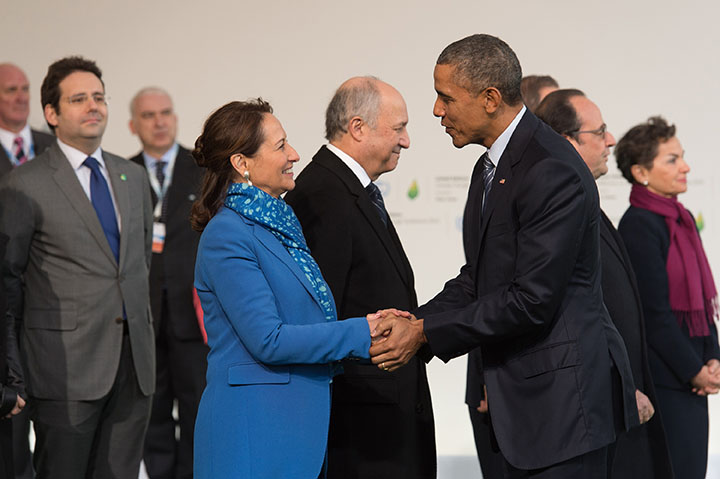Historic Climate Change Deal
French Minister for Ecology, Sustainable Development and Energy, Segolene Royal shakes hands with U.S. President Barack Obama during the official opening of the COP21 UN Conference on Climate Change on Nov. 30, 2015 held at Le Bourget, near Paris, France. (Pierre Villard/Abaca Press/TNS)
At the 21st annual meeting of the Conference of the Parties (COP21) on Saturday, Dec. 12, delegates from 195 nations meeting in Paris, France announced a historic climate change agreement.
For the first time in history, almost every country in the world will be legally bound to contribute to a global effort to protect the planet.
The end goal? Limiting global warming to less than 2 degrees Celsius higher than pre-industrial levels. Furthermore, the accord strives for 1.5 degrees, an unprecedented target, to protect island nations from sea level rise.
The 195 member countries of the Conference of the Parties (COP) meet every year to assess the progress of the United Nations Framework Convention on Climate Change (UNFCCC), which was adopted in 1992 at the Rio de Janeiro Earth Summit, which was the first international political conference addressing climate change.
The Convention acknowledges that humans have caused climate change and charges mostly industrialized countries with minimizing this change. Although COP15 in Copenhagen, Denmark failed to achieve a follow-up to the Kyoto Protocol, a reductions policy adopted in COP3, last year’s conference in Lima, Peru established the “Lima Call for Climate Action” and left leaders hopeful about future international cooperation in fighting climate change.
This new agreement requires each country to present a new plan every five years for reducing its greenhouse gas emissions, starting in 2020. Ideally, renewable energies such as solar and wind power will eventually replace fossil fuels, and countries will be able to work toward carbon neutrality in the second half of the century.
The Paris agreement also establishes an “enhanced transparency framework” holding all countries involved in the agreement accountable for climate action. Industrialized countries (including Japan, Australia, and the United States) will provide support and funding to help developing countries (including Afghanistan, the Democratic Republic of Congo, and Haiti) create renewable energy systems. However, the agreement asks developing countries only to contribute on a voluntary basis.
To encourage developed countries to contribute, the preamble of the agreement calls for industrialized countries to raise $100 billion per year from 2020 to fund global environmental protection projects and new energy systems for developing countries. This has sparked mixed reactions among critics, especially since the preamble is not legally binding.
Before the Paris summit, 186 countries – including the United States and China, the two worst contributors of greenhouse gases – had already submitted their Intended Nationally Determined Contributions (INDCs), or plans for cutting their greenhouse gas emissions.
Unfortunately, these plans include only half of the necessary emission reductions and would result in global warming between 2.7 and 3.5 degrees Celsius by the end of the century. However, experts say that the Paris conference is a promising start on containing global warming and climate change.
As French Foreign Minister Laurent Fabius, the president of the convention, declared proudly, “The Paris Agreement allows each delegation and group of countries to go back home with their heads held high.”
Countries can sign the Paris agreement on Earth Day, April 22, in New York. The agreement will go into effect as soon as it is ratified by 55 countries that, combined, represent at least 55 percent of global emissions.

Michelle Qin '19 is an editor for the Science and Technology section. As a senior, this is her fourth year of writing for The Banner. When she is not writing...


